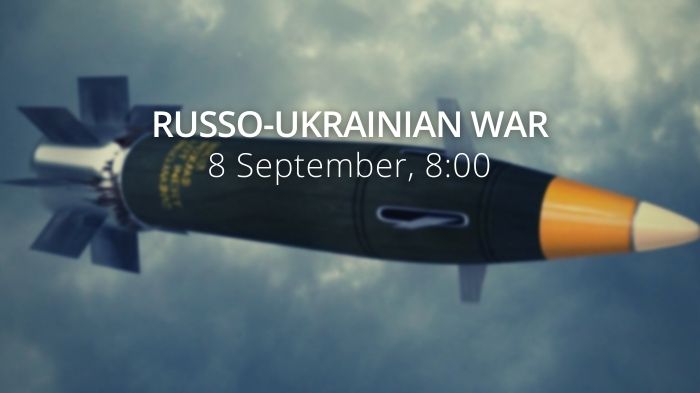“Counteroffensive and defensive actions are taking place,” Zelenskyy says. Russian forces in Zaporizhzhia Oblast defend against Ukrainian attacks. Kakhovka Reservoir is 62% empty after dam destruction. Russian Shahed drone attack on Odesa kills three civilians.
Daily overview — Summary report, June 11
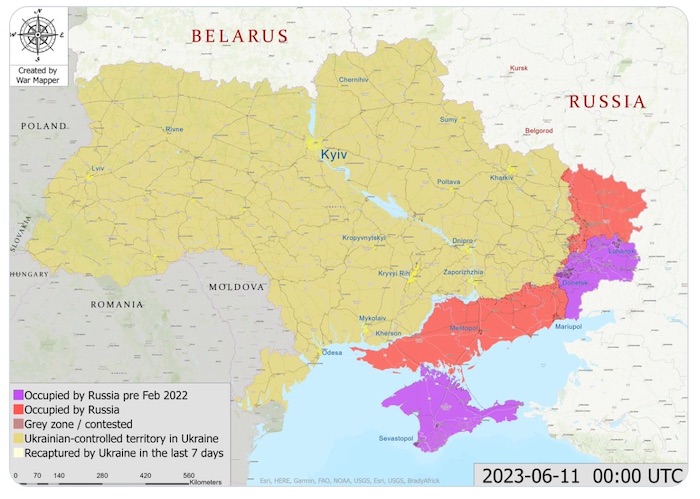
The General Staff’s operational update regarding the Russian invasion as of 18.00 pm, June 11, 2023 is in the dropdown menu below:
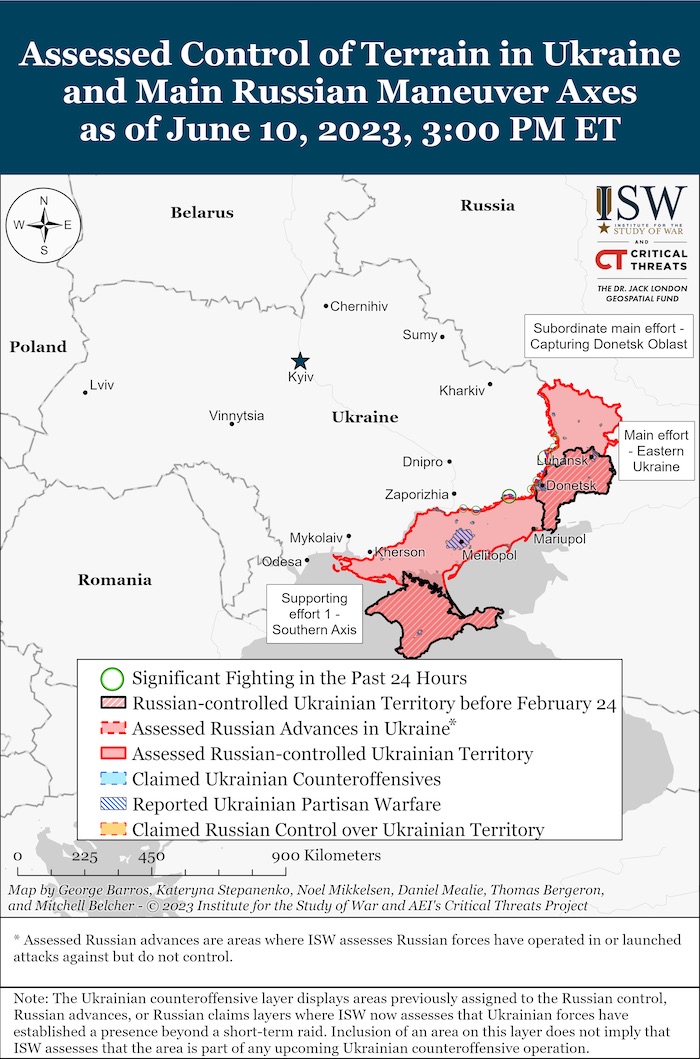

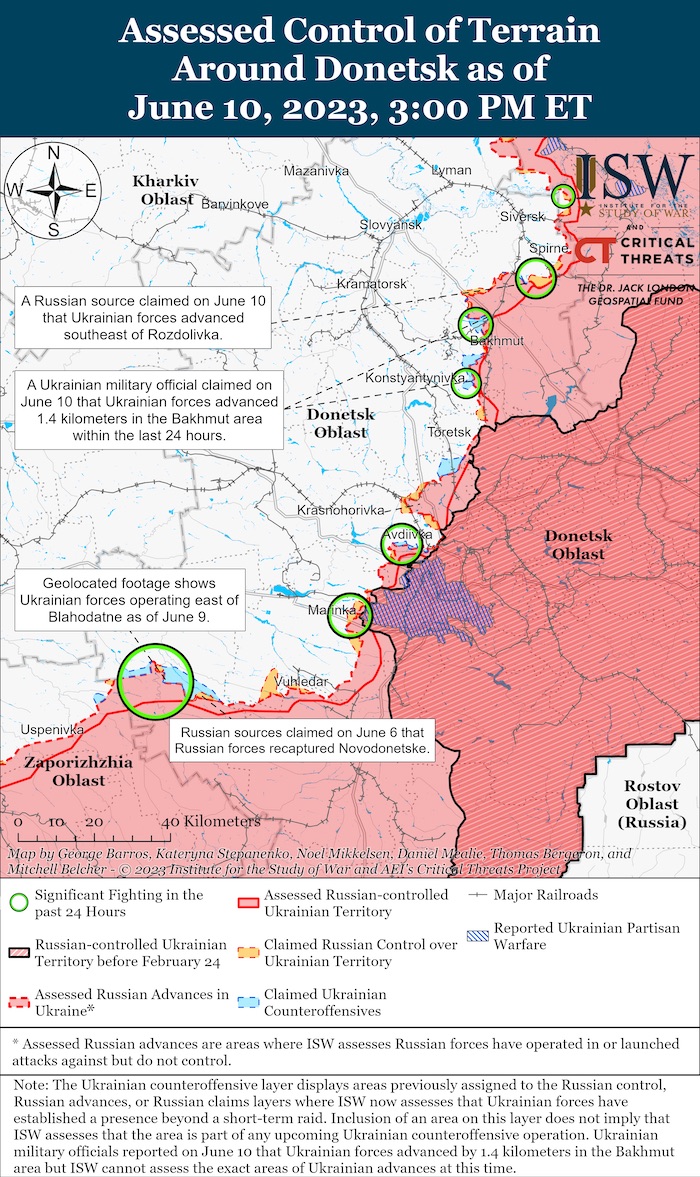
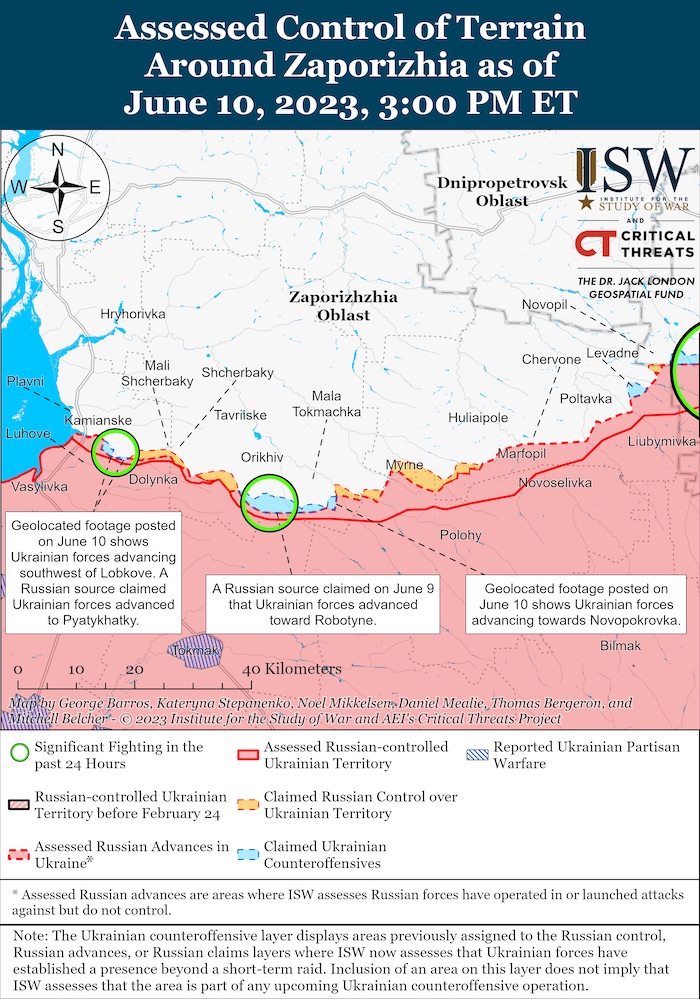

Military Updates
“Counteroffensive and defensive actions are taking place,” Zelenskyy says. During his joint press conference with Canadian PM Justin Trudeau in Kyiv on 10 June, Ukrainian President Volodymyr Zelenskyy acknowledged that Ukrainian troops are carrying out “counteroffensive and defensive actions” but noted that he would not say what stage they were at. Journalists asked Zelenskyy about Russian President Putin’s claim on 9 June that the Ukrainian counteroffensive had started and Ukrainian troops were allegedly sustaining “significant losses.”
Ukrainians advanced up to 1,4 km near Bakhmut on 9 June – Ukrainian military. In the past 24 hours, Ukraine’s defense forces have advanced up to 1,400 meters in some areas near Bakhmut, Donetsk oblast, according to a Ukrainian military spokesman. On the morning of 10 June, the Ukrainian Army’s Eastern Group of Forces spokesman Serhii Cherevatyi says on the national telethon that the Ukrainian troops are carrying out strikes against the enemy, taking advantage of the ongoing of rotations in the Russian forces in the area.
So how many Leopard tanks did Ukraine lose near Mala Tokmachka? The internet is abuzz with Ukraine’s first losses of Western equipment in the rough start of its counteroffensive. The battleground tracking collective Deepstatemap has analyzed the available footage shared by Russian media and estimated how much equipment took part in the two unsuccessful attacks on Mala Tokmachka.
Russian cruise missiles fly in circles around cities to exhaust Ukraine’s air defense – official. In addition, Shahed kamikaze drones exhaust Ukraine’s ammunition and identify weak points in air defense. Russia continues its campaign of terrorizing Ukraine through air strikes, aiming to target the weak points in the country’s air defense system and sow panic among its citizens, according to Colonel Yuri Ignat, spokesperson for the Ukrainian Air Force.
Ukraine likely hit Russian army headquarters visited by Putin, OSINT analysts say. Ukrainian forces have likely hit a Russian army headquarters in the occupied part of Kherson Oblast (southern Ukraine) that Vladimir Putin visited last April, according to Benjamin Pittet, an OSINT analyst. The Russian army headquarters in Kherson Oblast was reportedly hit by missiles on 10 June 2023, which was confirmed by a video surfacing on social media on Friday.
Ukrainian army liberates Blahodatne in southwestern Donetsk Oblast – 68th Jaeger Brigade
According to British Defence Intelligence, (last 48 hours):
- The collapse of the Kakhovka Dam on 06 June 2023 has almost certainly severely disrupted the occupied Crimean Peninsula’s primary source of fresh water, the North Crimean Canal (NCC).
- The NCC draws water from the Kakhovka Reservoir, from an inlet higher than the bed of the reservoir. The water level in the reservoir had likely dropped below the level of the inlet by 09 June 2023 and water will soon stop flowing to Crimea.
- This will reduce the availability of fresh water in southern Kherson Oblast and northern Crimea. However, the Russian authorities will likely meet the immediate water requirements of the population using reservoirs, water rationing, drilling new wells, and delivering bottled water from Russia. Concurrently, communities on both the Russian and Ukrainian-controlled sides of the flooded Dnipro are facing a sanitation crisis with limited access to safe water, and an increased risk of water-borne diseases.
Losses of the Russian army
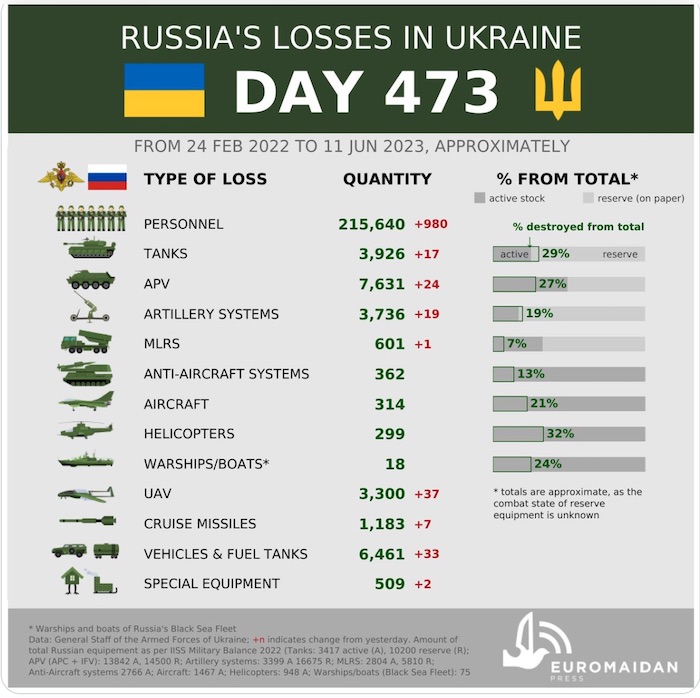
Humanitarian
Russian Shahed drone attack on Odesa kills three civilians. In the early hours of 10 June, Russian forces attacked the southern Ukrainian city of Odesa with Iranian-made Shahed-series one-way attack drones. The Ukrainian military says to have destroyed all the incoming drones in Odesa, but debris from one of those crashed into a residential high-rise apartment building, killing three.
Environmental
Russian troops loot flooded Oleshky in Kherson Oblast, mayor says. According to Mayor Yevhen Ryshchuk, in the occupied Oleshky administrative unit, Russian troops are taking away private cars, storming into houses, and stealing the property of local residents, UkrInform reported. In addition, the occupiers stole a boat of volunteers and used it to transfer looted things from the city instead of helping people trapped in their homes due to the flood caused by the destruction of the Nova Kakhovka dam.
Kakhovka Reservoir is 62% empty after a dam destruction. The Kakhovka Reservoir is 62% empty after the destruction of a Nova Kakhovka dam in Kherson Oblast as of 10 June, says Ukrainian Minister of Environmental Protection Ruslan Strilets. According to the minister, Ukraine estimates the environmental damage caused by Russian troops at over $1,5 billion.
Interior Ministry: four dead, 27 people missing as 47 settlements remain flooded in Kherson Oblast. On 10 June, Ukrainian Interior Minister Ihor Klymenko said 27 people are considered missing in Kherson Oblast, while 47 settlements are still flooded after the Russian troops destroyed the Kakhovka Dam. Of those, 33 settlements are on government-controlled territory and 14 are Russian-occupied. A total of 2,620 people have been evacuated, 160 of them are children, and four people have died in Kherson Oblast.
Legal
ICC mission arrives in Kherson Oblast to investigate destruction of Nova Kakhovka dam. Ukrainian Prosecutor General Andrii Kostin met with representatives of the International Criminal Court (ICC), who arrived in Kherson Oblast to investigate the destruction of a Nova Kakhovka dam which unleashed an environmental catastrophe in Ukraine. “My colleagues have arrived in Kherson Oblast to prepare for an investigation into an explosion at the Kakhovka Hydroelectric Power Plant. They will see everything with their own eyes and draw their conclusions. The world must know the truth about the horrific crimes that Russia is committing in Ukraine,” emphasized Kostin.
Russian war kills 487 Ukrainian children, prosecutors say. Ukraine’s Prosecutor’s Office has said the Russian war has killed 487 and injured more than 1014 children. The prosecutors say the number of casualties is not final, as Ukrainian police have no access to combat zones and occupied territories. Earlier, Ukrainian police reported that three civilians were killed, and 26 were injured, including two children, in a Russian drone attack on Odesa.
Support
Trudeau announces C$500 million aid package, Ukraine F-16 pilot training during visit to Kyiv. During his visit to Kyiv on 10 June, Canadian Prime Minister Justin Trudeau announced a new C$500 million military aid package for Ukraine, Suspilne reports. In particular, Canada will provide the Ukrainian Defense Forces with 287 additional missiles and 10,000 shells. He also said that Canada would join the training of Ukrainian pilots on F-16 fighters. In addition, Trudeau promised to hand over a Russian An-124 transport plane detained in Canada last year to Ukraine.
New Developments
Press conference by Ukrainian POWs in Hungary to denounce Ukraine, praise Russian Orthodox Church. Ukrainian prisoners of war in Hungary are reportedly preparing to publicly criticize Ukraine and express gratitude to the Russian Orthodox Church, as part of a mandatory condition for their release from Russia. Ukrainian prisoners of war who were transferred to Hungary by the Russian Orthodox Church (ROC) instead of going to Ukraine are reportedly preparing for a press conference, where they are expected to criticize Ukraine and express gratitude to the ROC, the Ukrainian media RBK reports, citing its sources in Ukrainian intelligence. Russian Orthodox Church transfers Ukrainian POWs to Hungary. Vice Prime Minister of Hungary, Zsolt Semjén, has confirmed that 11 Ukrainian POWs of Hungarian descent were transferred from Russia to Hungary, as previously announced by the Russian Orthodox Church.
Russian troops hit 11 Ukrainian oblasts over the last 24 hours. According to Ukrainian regional military administrations, Russian troops targeted Sumy, Zaporizhzhia, Kharkiv, Dnipropetrovsk, Luhansk, Donetsk, Poltava, Chernnihiv, Mykolaiv, Odesa, Kherson oblasts with artillery, Iskander-K cruise missiles, and Iranian-made drones over the last 24 hours, UkrInform reported. On 9 June, a Russian attack killed three civilians and injurVice Prime Minister of Hungary, Zsolt Semjén, has confirmed that 11 Ukrainian POWs of Hungarian descent were transferred from Russia to Hungary, as previously announced by the Russian Orthodox Church.ed 26 in Odesa after pieces of Shahed drones hit a nine-story residential building. In addition, ten people were injured in Bilhorod-Dnistrovskyi city in Odesa oblast.
Assessment
- On the war.
The Institute for the Study of War has made the following assessment as of June 10, 2022:
Ukrainian forces conducted counteroffensive operations in at least four areas of the front on June 10. Russian sources reported Ukrainian activity in Luhansk Oblast near Bilohorivka.[1] Ukrainian Eastern Group of Forces Spokesperson Colonel Serhiy Cherevaty noted that Ukrainian forces advanced up to 1,400m in unspecified areas of the Bakhmut front, and Russian milbloggers reported Ukrainian advances northwest and northeast of Bakhmut.[2] The Russian Ministry of Defense (MoD) and other Russian sources claimed that Ukrainian troops conducted localized attacks in the Donetsk-Zaporizhzhia Oblast border area, particularly in the Velyka Novosilka area.[3] Geolocated footage posted on June 10 additionally indicates that Ukrainian forces in western Zaporizhzhia Oblast made localized gains during counterattacks southwest and southeast of Orikhiv, and Russian milbloggers continued to claim that Russian forces in this area are successfully defending against attempted Ukrainian advances.[4]
Russian forces in Zaporizhzhia Oblast are continuing to defend against Ukrainian attacks in accord with sound tactical defensive doctrine. A Russian milblogger claimed that Russian defensive operations in southern Ukraine are relying on three main components: early detection and destruction of Ukrainian assault formations, massive use of anti-tank weapons, and mining of territories near Russian defensive positions.[5] The milblogger claimed that minefields have a twofold effect by initially damaging Ukrainian armored vehicles when they attempt to breakthrough the minefield and then again when they retreat from the area.[6] ISW previously assessed that Russian forces responded to the start of Ukrainian counteroffensive operations in western Zaporizhzhia Oblast following established Russian doctrine, which calls for a first echelon of troops to repel or slow attacking forces with minefields, fortifications, and strongpoints, and a second echelon of forces to counterattack against any enemy breakthrough.[7] Russian reporting of Ukrainian assaults in southern Ukraine in recent days suggests a pattern in which Ukrainian forces conduct limited breakthroughs and temporarily occupy new positions before Russian forces later recapture or push Ukrainian forces out of those positions.[8] This tactical pattern indicates that Russian forces have likely maintained doctrinally sound defensive operations in southern Ukraine, though as ISW previously reported, defending units of the 58th CAA are likely some of the most effective Russian units currently deployed in Ukraine.[9]
Russian milbloggers continue to highlight reported superior Russian electronic warfare (EW) capabilities as key to disrupting Ukrainian attacks. Russian milbloggers claimed that Russian EW units are disrupting Ukrainian communications as well as aviation units and alleged that some Ukrainian mechanized groups were not prepared to fight without communications or with suppressed GPS.[10] Another milblogger claimed that Ukrainian forces attempted their own “electronic counter measures” against Russian reconnaissance and control capabilities in areas where there are Ukrainian assaults but that these attempts were unsuccessful.[11] Russian forces have reportedly successfully improved their EW use throughout the invasion of Ukraine.[12]
Russian sources claimed that Ukrainian forces have tactical advantages in conducting assaults at night due to Western-provided equipment with superior night optics systems. A prominent Russian milblogger claimed that Ukrainian forces are launching assaults at night because Western-provided equipment provides Ukrainian forces with “excellent” night vision optics.[13] Zaporizhzhia Oblast occupation official Vladimir Rogov also claimed that night assaults allow Ukrainian forces to more effectively use Western-provided equipment.[14] Russian sources have widely claimed that Ukrainian forces have started or intensified assaults at night in recent days, and Ukrainian forces may be increasingly leveraging the advantages provided by Western systems.[15]
Russian sources continue to highlight the role of scarce military district-level Russian TOS-1A thermobaric artillery systems against Ukrainian attacks, though Ukrainian forces destroyed at least two of these key systems in recent days. Geolocated footage published on June 8 and 9 confirms that Ukrainian forces have used Western precision munitions (reportedly the Paladin 155mm artillery system) to destroy at least two Russian TOS-1A thermobaric artillery systems – highly destructive but scarce artillery assets controlled at the Russian military district level – in western and eastern Zaporizhzhia Oblast during the Ukrainian counteroffensive.[16] The Russian Ministry of Defense (MoD) highlighted the role of Russian thermobaric artillery systems in striking Ukrainian positions on the western Zaporizhzhia Oblast frontline.[17] A Russian milblogger claimed that Russian thermobaric artillery units have consistently fired on Ukrainian forces on the Donetsk-Zaporizhzhia Oblast administrative border and in western Zaporizhzhia Oblast for the past several days and characterized the units as essential to repelling Ukrainian frontal assaults.[18] Russian forces’ apparent reliance on specific artillery assets is noteworthy, as precision Ukrainian strikes on these systems could potentially complicate Russian defensive capabilities and Russian forces are unlikely to possess enough TOS-1A systems to provide the same level of fire support all along the front line.
Ukrainian forces are currently attempting an extraordinarily difficult tactical operation – a frontal assault against prepared defensive positions, further complicated by a lack of air superiority – and these initial assaults should not be extrapolated to predict all Ukrainian operations. Ukrainian forces are unsurprisingly taking casualties in initial attacks against some of the best-prepared Russian forces in Ukraine. However, initial attacks – and particularly selected footage that Russian sources are intentionally disseminating and highlighting – are not representative of all Ukrainian operations. The Russian military remains dangerous and Ukrainian forces certainly face a hard fight, but Ukraine has not yet committed the vast majority of its counteroffensive forces and Russian defenses are not uniformly strong along all sectors of the front line.
Chechen Republic Head Ramzan Kadyrov established a clear rhetorical line between criticizing the Russian MoD and criticizing Russian President Vladimir Putin in a statement on June 9. Kadyrov published a post to Telegram on June 9 outlining the details of a private phone call that occurred between Kadyrov and Wagner Group financier Yevgeny Prigozhin in late May after Kadyrov and Prigozhin reportedly reached an agreement for Chechen forces to replace Wagner in Bakhmut.[19] The interactions between Kadyrov and Prigozhin rapidly deteriorated in subsequent days, but Prigozhin claimed that he personally called Kadyrov on June 1 to resolve their dispute.[20] Kadyrov claimed on June 9 that he genuinely believed he was doing his best to help Prigozhin by offering for Chechen troops to replace Wagner fighters but that Prigozhin’s tone towards Kadyrov and the Chechen troops changed suddenly, and Kadyrov felt as though he had to personally mitigate.[21] Kadyrov also noted that he himself has occasionally criticized the Russian MoD but rhetorically drew a line against criticizing Putin directly, claiming he has always understood that Putin’s position as the Supreme Commander-in-Chief of the Russian Armed Forces means that Putin has the best understanding of battlefield realities.[22] Kadyrov then criticized Wagner for being a weak and ineffective force when faced with the same operational restraints as Chechen forces in previous phases of the war.[23] Kadyrov’s message likely sought to signal his loyalty to Putin and portray Prigozhin as further at odds with the overall Russian military leadership.
Russian forces targeted a Ukrainian operational airfield during another missile and drone strike on Ukraine on the night of June 9 to 10. Ukrainian Air Force Command reported on June 10 that Russian forces launched eight ground-based missiles of various types and 35 Shahed-type drones at Ukraine from the northern and southern directions and hit an operational airfield in Poltava Oblast with Iskander ballistic missiles, cruise missiles, and Iranian-made drones.[24] Poltava Oblast Head Dmytro Lunin noted that the strike damaged airfield infrastructure and other unspecified equipment.[25] Former Donetsk People’s Republic (DNR) spokesperson Eduard Basurin praised the strike for “finally” targeting Ukrainian airfields.[26] ISW recently assessed that Russia is conducting a new air campaign to target Ukrainian counteroffensive capabilities, and Russian sources will likely use reporting of such strikes to frame the current air campaign as proactive and effective over the backdrop of Ukrainian counterattacks throughout the theater.[27]
Key Takeaways
- Ukrainian forces conducted counteroffensive operations in at least four areas of the front on June 10.
- Russian forces in Zaporizhzhia Oblast are continuing to defend against Ukrainian attacks in accord with sound tactical defensive doctrine.
- Russian milbloggers continue to highlight reported superior Russian electronic warfare (EW) capabilities as key to disrupting Ukrainian attacks.
- Russian sources claimed that Ukrainian forces have tactical advantages in conducting assaults at night due to Western-provided equipment with superior night optics systems.
- Russian sources continue to highlight the role of scarce military district-level Russian TOS-1A thermobaric artillery systems in defending against Ukrainian counteroffensive operations, though Ukrainian forces destroyed at least two of these key systems in recent days.
- Ukrainian forces are currently attempting an extraordinarily difficult tactical operation – a frontal assault against prepared defensive positions, further complicated by a lack of air superiority – and these initial assaults should not be extrapolated to predict all Ukrainian operations.
- Chechen Republic Head Ramzan Kadyrov established a clear rhetorical line between criticizing the Russian Ministry of Defense (MoD) and criticizing Russian President Vladimir Putin.
- Russian forces targeted a Ukrainian operational airfield during another missile and drone strike on Ukraine on the night of June 9 to 10.
- Russian forces made marginal advances northeast of Kupiansk and continued ground attacks near Kreminna.
- Russian and Ukrainian forces both continued ground attacks in the Bakhmut area.
- Russian forces continued limited ground attacks along the Avdiivka-Donetsk City line.
- Ukrainian forces continued limited ground attacks near the administrative border between Donetsk and Zaporizhzhia oblasts and have made marginal gains in the area as of June 10.
- The Russian Ministry of Defense (MoD) announced on June 10 that it plans to formalize the organization of volunteer formations.
- Russia is further consolidating a centralized media apparatus in occupied areas.




